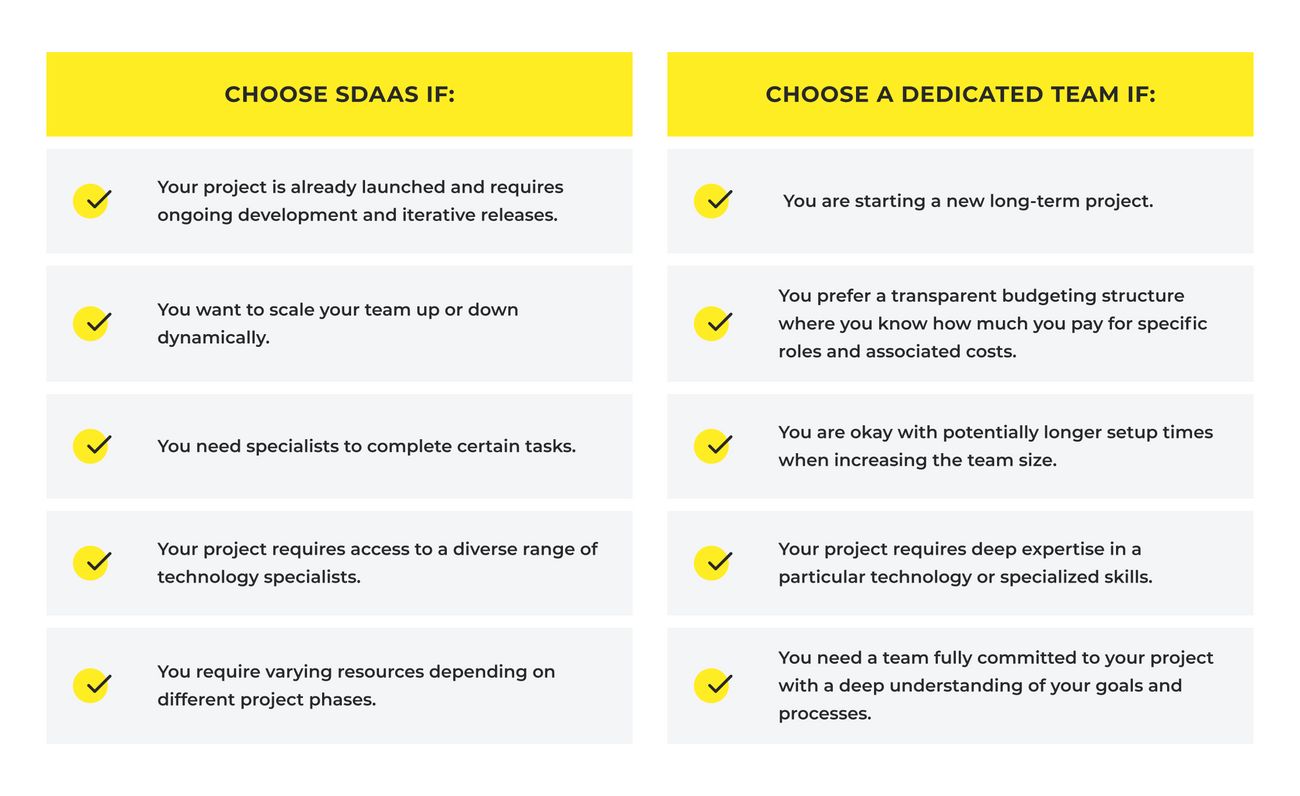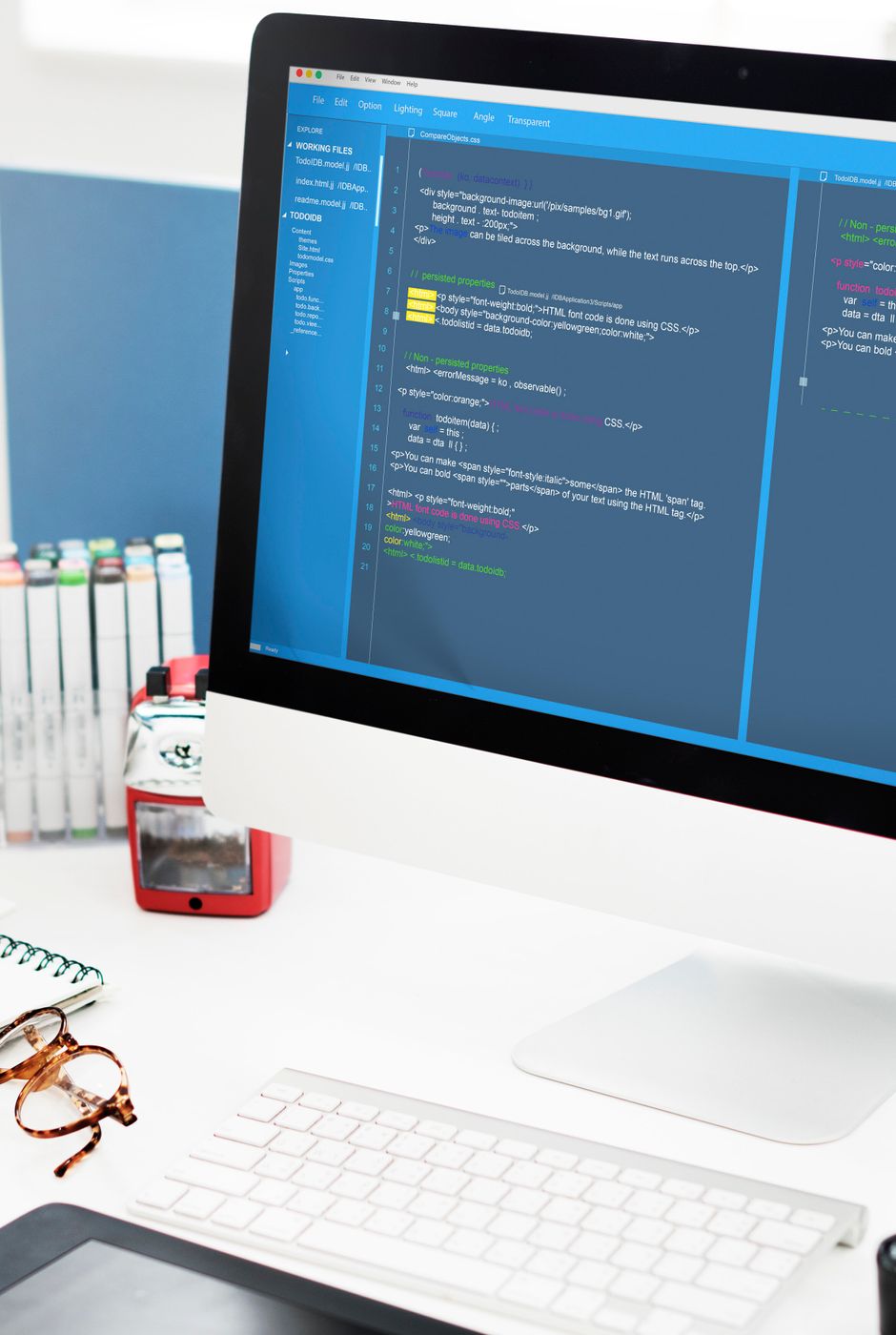It’s safe to say that SaaS has transformed the way we access and use software, making it more flexible, scalable, and convenient. So, why not apply this proven concept to software development? Just like you pay a monthly fee to access content on Netflix, with software development as a service (SDaaS), you pay a regular fee to access a range of expertise and resources. It allows you to scale your software development team as your projects grow.
But how can you be sure that SDaaS, also known as software development as a service, is the right choice for your business? Is it worth exploring or should you consider alternative software development services? While you can think of other engagement models, such as team augmentation, project-based development, or even hiring a dedicated software development team, software development as a service allows you to leverage the expertise of a dedicated team without the overhead of managing a full-time team. This makes SDaaS a compelling choice if you want to accelerate your software development efforts while maintaining a high level of quality and control.
To help you make an informed decision, we’ll compare software development as a service with getting a dedicated team from software development companies. But first, let's dive into what SDaaS is and how it works.
What is Software Development as a Service (SDaaS)?
Software development as a service, also known as software engineering as a service, also known as SDaaS, is a subscription-based model that lets companies outsource development on demand. SDaaS was “invented” in response to the challenges associated with traditional pricing models in software development outsourcing, such as high costs, vendor dependency, and complex cost structures.
Depending on your needs, with SDaaS you can get either one developer as a service or the whole development team. For example, imagine a fintech start-up aiming to launch an AI-powered analytics platform. You have a solid in-house team in place, but you suddenly realize you need one more developer to speed up the process. Instead of launching a new hiring campaign, you find an SDaaS provider and quickly access specialized AI developers and data scientists, scaling the team as needed.
This approach allows you to accelerate the platform’s launch, maintain budget flexibility, and stay competitive. You don't need to spend time and money on traditional hiring.
Read also: In house software development vs outsourcing
Or one more example. Let’s say you have two products: a newly launched app that’s gaining traction, and an already established product that requires regular maintenance. Your current team is fully engaged with the new project, but your older product still needs attention like bug fixes and routine updates. You don’t have extra specialists to work on your old product. Hiring full-time developers in-house is long and expensive. You don’t need that. You can opt for SDaaS and quickly get matched with the needed engineers at a predictable cost, keeping both products on track without straining your resources.
If you prioritize speed and cost optimization, hiring talent in-house is definitely not a viable alternative to SDaaS. But the option of working with a dedicated team is still on the table. Let’s briefly review how these models differ.

Software engineering as a service vs dedicated team
On the surface, both SDaaS and the dedicated team model offer access to a group of specialists to work on your project. However, understanding the differences between these approaches is crucial when making a choice. Below, we will compare SDaaS and dedicated teams.
Software as a service development operates on a subscription model, where you pay for ongoing access to development resources. You maintain control over task assignments, but the actual resources involved might vary. As a result, you may not always know the specific individuals working on your project, nor their exact expertise. Besides, an SDaaS provider might distribute resources between multiple clients, which could result in less focus on your project.
Now let’s imagine you are building your application with a dedicated team. You thoroughly choose and approve every team member—developers, designers, QA specialists—and they work exclusively on your project. While the dedicated team provider manages all operational processes, your team is committed to achieving your project goals and delivering a high-quality product.
SDaaS offers high flexibility and scalability, allowing you to adjust your team size as needed. For example, if you need 5 specialists this month to speed up your product release, you can subscribe to a plan with 5 team members. Once the release is complete, you can scale down to just 2 developers.
The dedicated team is just as flexible but scaling up the team might involve longer times. For example, being a software development company ourselves, our core team can start working immediately. When you need to increase your team, we give you the flexibility to hire our in-house developers or source candidates at your preferred salary from the market. If you choose the latter, the process of sourcing, vetting, hiring, and onboarding newcomers typically takes around a month. However, thanks to our proactive approach to collaboration, we can anticipate your needs early and get new team members up to speed more quickly. Also, with access to a talent pool of 16,000 software developers, we significantly accelerate the sourcing process.
In the SDaaS model, providers typically offer packages that align with your project’s usage needs, so you can choose a plan that fits your specific requirements. These packages are often flexible, with opportunities to add or scale software development services on demand as your project evolves. While SDaaS provides a predictable cost structure that makes budgeting easier, one downside is the lack of transparency. When paying a subscription fee, it can be unclear how costs are allocated.
Here’s how it typically works: An SDaaS provider supplies development resources and assigns a Project Manager to act as an intermediary between you and your team. Team members may rotate throughout the project without your knowledge of who is working on it, their expertise, seniority, or location. The breakdown of the subscription cost is often unclear.
With the dedicated team, costs are transparent. Your monthly invoice includes a developer’s salary and a fixed monthly fee—no hidden costs. This way, you know how much each developer earns and what the monthly fee covers. You avoid overpaying and maintain clear control over your budget.
In SDaaS, communication is typically less frequent and is managed through service-level agreements (SLAs). The client interacts with a PM at key milestones or during specific updates, but the interaction is often structured and formal, with less day-to-day involvement.
When it comes to the dedicated team, it operates like a bustling beehive, with Slack messages and constant updates. Daily calls, weekly syncs, and monthly meetings keep you closely connected with the team and in the know of every project detail. Active communication ensures quick feedback, keeps everyone aligned with project goals, and strengthens the working relationship. The result is a seamless, dynamic partnership where your project progresses smoothly and efficiently.
With SDaaS, you gain access to a wide talent pool and can fill any position your project requires. However, you can’t verify the accuracy of the expertise listed on the developers’ CVs or how thoroughly they were vetted. Plus, these developers are not dedicated to your project and may rotate. Each time a new specialist joins, they must start learning about your project from scratch. Can you be sure they really understand what's going on?
The approach is completely different from the dedicated team model. When assembling such a team, we keep your project needs in mind. Every specialist is chosen to fulfill specific responsibilities within your project scope. At Kultprosvet, we thoroughly vet new hires before they join your project. Our screening process covers everything from soft skills to technical know-how. Only the top 5% make it to your interview, so you can be confident you’re meeting the best of the best.
After two rounds of selection and a month of onboarding where newcomers learn best practices and quality standards, they are assigned to your project. In case a developer doesn’t fit your requirements, we provide a replacement or a refund within 30 days at no extra cost.
When to choose SDaaS
SDaaS is a working solution to fill temporary gaps in your development team when you face tight deadlines or need experts for particular tasks.
Unlike SDaaS where developers usually work on existing projects, a dedicated team is often used for working on new long-term projects that require consistency and in-depth product knowledge. Such a team provides the focused expertise and commitment necessary to build a great product.
Once you’re familiar with the details about both models, here are the checklists to help you distinguish between them:

Things to be aware of when choosing an SDaaS model
If you’re leaning toward SDaaS after reading the checklist, it’s important to recognize the potential challenges that come with this approach. SDaaS can offer many advantages, but it also presents certain risks that you should be ready to navigate. Here are some of the most common pitfalls to be aware of before partnering with an SDaaS vendor.
Unlike an in-house or dedicated team, where you maintain day-to-day control, the SDaaS model shifts your focus to the final outcome rather than the development process itself. This can limit your ability to influence daily decisions and adjust priorities in real-time. As a result, you might be less involved in the project management and strategic adjustments, which can affect how well the project aligns with your expectations.
While SDaaS is often considered highly predictable and cost-effective, it can carry hidden costs that aren’t immediately apparent. Additional services, changes in project scope, or the need to scale up the resources can lead to unexpected expenses that impact your budget. For example, you start with a subscription that meets your current needs, but as new tasks add up, the plan doesn’t work anymore. You have to upgrade to a more expensive plan or pay extra for additional services.
The SDaaS provider is responsible for delivering quality work, but there's a risk that quality might decline, especially if they frequently reallocate resources. Different team members with varying expertise and soft skills may join your project over time. With less control over who works on your project, you might see inconsistencies in quality and shifts in team dynamics.
If these risks made you hesitate about the effectiveness of SDaaS, consider other options like a dedicated team model or staff augmentation model. If you have any questions, don't hesitate to reach out.
Can a software developer as a service fully replace a dedicated team model?
Answering this question, let’s put aside the advantages of SDaaS we’ve already covered, like flexibility, adaptability, and cost-effectiveness, and focus on its ideal use case. SDaaS works great in handling specific tasks, but it’s not built for long-term projects that require deep, consistent collaboration.
Think of your business as a climbing trip to Everest. SDaaS is like hiring several guides who provide essential support for different stages of the climb. However, they won’t be with you throughout the entire journey. The dedicated team, in contrast, means having a group of experienced climbers who are with you from base camp to the summit. They know every step of the way and adapt to your needs as you tackle the mountain.
So, can SDaaS fully replace other outsourcing models? The answer is no. If you need experts specifically tailored to your project and fully committed to it, it’s better to assemble one from scratch.
